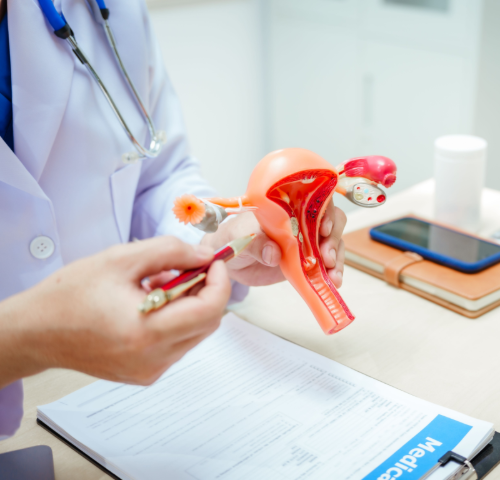Human reproduction involves a lot of moving parts. As you progress through your fertility journey, you’re likely to become something of an expert on every aspect of getting pregnant. One aspect that’s going to play a particularly important role in getting pregnant is making sure that your uterine lining is ready for embryo implantation.


Commonly referred to as the uterine lining, the endometrium is the layer of tissue (or mucus membrane) that lines the inside of the uterus. Over the course of a menstrual cycle, this mucus membrane thickens in anticipation of a possible pregnancy. Ideally, the endometrium will reach a thickness of at least 8 mm by the time a fertilized egg descends into the uterus for implantation. If implantation doesn’t occur, then the lining thins and sheds, which results in menstrual bleeding.
Commonly referred to as the uterine lining, the endometrium is the layer of tissue (or mucus membrane) that lines the inside of the uterus. Over the course of a menstrual cycle, this mucus membrane thickens in anticipation of a possible pregnancy. Ideally, the endometrium will reach a thickness of at least 8 mm by the time a fertilized egg descends into the uterus for implantation. If implantation doesn’t occur, then the lining thins and sheds, which results in menstrual bleeding.
Simply put, the endometrium is where conception happens. When a natural pregnancy occurs, the fertilized egg has traveled along the fallopian tube(s) and descends into the uterus during the window of implantation (WOI). This begins the process of implanting in the uterine lining. During IVF, rather than descending through the fallopian tube, the embryo is transferred directly into the uterus for implantation.
Despite the advances in assisted reproductive technology, implantation success is still dependent on your endometrium selectiveness. It doesn’t want to “waste” nutrients and other resources on a lower quality embryo, so it “feels out” if an embryo is healthy. When embryos are healthy and the necessary physiological conditions met, the endometrium doesn’t do anything to prevent the implantation process. However, if it detects a low-quality embryo, the endometrium will take action in order to prevent the embryo from developing further.
Embryo-endometrium synchrony occurs when the embryo reaches the endometrium at the time when it is most receptive. As much as 30% of women who struggle to conceive have a WOI that is shorter or displaced, which means the embryo and endometrium will be out of sync. It can be difficult to know if you have a non-standard or displaced WOI, as this is not something that can be detected by standard female infertility testing such as ultrasound.
Endometrial receptivity has to do with creating the optimal conditions for an embryo to implant and grow into a baby. During every menstrual cycle, there is a two-to-three-day window where the endometrium is at peak receptivity. Referred to as the window of implantation (WOI), this typically occurs between day-19 and day-21 of a 28-day menstrual cycle.
Currently, the only way to accurately test endometrial receptivity is analyze an endometrial tissue biopsy sample through molecular testing methods. If you decide to take an endometrial receptivity test (ERT) like MIRA™, your fertility specialist will perform a mock cycle as part of your IVF treatment protocol. A mock cycle bears similarity to a frozen embryo transfer (FET) in that you will be prescribed hormones to help prepare your endometrium. During the height of your estimated WOI, a tissue sample is collected, and its molecular biomarkers analyzed to determine if you are receptive at the time of the biopsy.
The ERT biopsy can be invasive and even painful at times since anesthetics are not typically given for the procedure. Inti Labs’ endometrial receptivity test MIRA™ uses microRNA (miRNA) biomarkers instead of the more common messenger RNA (mRNA). miRNA is a more stable genetic material that can be found in all bodily fluids and most cell types. The miRNA biomarkers used in the test correlate to more than 600 of the genes related to endometrial receptivity, and require a smaller tissue sample, making the biopsy less invasive and uncomfortable. This test also has a failure rate of less than 1%, making it one of the most reliable endometrial receptivity tests on the market.
There are several factors that can cause your endometrium to be thinner than what’s ideal for embryo implantation. If you are not producing enough estrogen naturally, your endometrium isn’t likely to reach the appropriate thickness. If taking estrogen medication does not improve your receptivity, it is possible that scarring caused by prior surgery, infection, or endometriosis may be impacting the overall function of your uterine lining. Poor blood flow through the uterine arteries has also been found to interfere with lining thickness and may require medications that improve blood flow.
Having endometriosis can make getting pregnant more difficult. Depending on the location and severity of the condition, there are a variety of ways that the disease can affect your reproductive organs. When it comes to embryo implantation, endometriosis is tied to higher rates of implantation failure. Likewise, it can reduce endometrial receptivity because of inflammation or immune suppression. There are still plenty of treatment options to overcome this. If you have concerns about endometriosis, speak to your doctor about whether or not you should treat it before IVF.
Hormones play a big role in preparing the endometrium for implantation. If you are undergoing a fresh embryo transfer, you will be administered progesterone in the second phase of your treatment, after the egg retrieval has taken place. For those who are undergoing a FET, or who have been found to have a thinner endometrium, estrogen will be administered orally or by patch at the beginning of the IVF cycle. Your fertility specialist will do a full evaluation before starting treatment to determine the specific support you need.
The most common way of measuring endometrial thickness is with an ultrasound. It’s for this reason that you will likely have frequent ultrasounds throughout your IVF treatment cycle. It should be noted that thickness alone does not determine receptivity. For the most accurate and precise information on your endometrial receptivity, it’s recommended that you take an ERT like MIRA™.